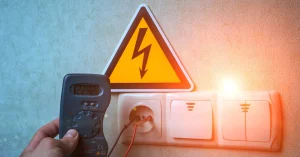Electrical hazards present significant risks in the workplace, affecting both safety and operational efficiency. Identifying these hazards is essential for organizations aiming to create a secure environment. Effective safety protocols can prevent incidents that lead to injuries and costly downtime. Furthermore, the correlation between safety measures and productivity is significant. Understanding this relationship lays the groundwork for exploring strategies that enhance both employee well-being and overall performance. What specific actions can organizations take to achieve this balance?
Key Takeaways
- Preventing electrical hazards significantly reduces workplace accidents, creating a safer environment for employees.
- A safe workplace boosts employee confidence, enhancing focus and productivity during tasks.
- Regular safety inspections and adherence to protocols streamline operations, improving overall efficiency.
- Compliance with safety standards lowers insurance costs and compensatory claims, benefiting the organization financially.
- Ongoing training fosters a culture of awareness, promoting responsibility and engagement among staff.
Understanding Electrical Hazards in the Workplace
Although many employees may underestimate the risks associated with electrical systems, understanding electrical hazards in the workplace is crucial for maintaining safety and productivity. Electrical hazards can manifest in various forms, including exposed wires, overloaded circuits, and improper grounding. Recognizing these risks enables employees to identify potential dangers before they escalate into more severe incidents. Implementing extensive training programs is essential for educating staff on how to prevent electrical hazards. Regular inspections of electrical equipment and adherence to safety standards further reduce the likelihood of accidents. By fostering a culture of awareness and responsibility, organizations can empower their workforce to actively participate in safety initiatives, ultimately enhancing overall workplace safety and productivity.
The Importance of Safety Protocols
Effective safety protocols serve as a fundamental framework for mitigating electrical hazards in the workplace. By establishing clear guidelines and procedures, organizations create a culture that prioritizes safety and encourages employee engagement. These protocols encompass risk assessment, regular training, and adherence to regulatory standards, ensuring that all personnel are well-informed about potential dangers. In addition, the implementation of safety protocols fosters an environment of accountability, as employees understand their roles in maintaining safety. This collective commitment not only reduces the likelihood of accidents but also enhances overall productivity, as a safe workplace minimizes disruptions and promotes efficiency. Consequently, organizations that prioritize safety protocols can expect improved morale and a stronger sense of belonging among their workforce.

How to Prevent Electrical Hazards: Best Practices
Implementing best practices for preventing electrical hazards is vital for maintaining workplace safety and operational efficiency. Organizations can enhance safety protocols by adhering to the following guidelines:
- Conduct Regular Inspections: Routine assessments of electrical systems help identify potential issues before they escalate.
- Use Proper Personal Protective Equipment (PPE): Confirming employees wear appropriate PPE reduces the risk of electrical injuries.
- Implement Lockout/Tagout Procedures: This practice guarantees that machinery is properly shut off and not started up again until maintenance is completed.
- Provide Thorough Training: Educating employees about electrical safety and hazard recognition fosters a culture of awareness and responsibility.
The Impact of Electrical Safety on Productivity
Electrical safety plays an essential role in enhancing productivity within various industries. When organizations prioritize electrical safety, they mitigate the risks associated with electrical hazards, resulting in fewer accidents and downtime. A safe working environment fosters employee confidence, enabling workers to focus on their tasks without the distraction of potential dangers. Consequently, this leads to improved overall efficiency and output. Additionally, compliance with electrical safety standards often results in streamlined operations, as businesses invest in better equipment and maintenance practices. The financial implications are significant; reduced incidents equate to lower insurance premiums and fewer compensatory claims. Therefore, the commitment to electrical safety not only safeguards personnel but also fortifies organizational productivity, creating a culture where safety and performance coexist harmoniously.
Implementing Electrical Safety Training and Awareness Programs
A robust approach to electrical safety training and awareness programs greatly enhances an organization’s commitment to preventing electrical hazards. Such programs not only minimize risks but also foster a culture of safety. Key components include:
- Comprehensive Curriculum: Covering electrical theory, safety regulations, and hazard recognition.
- Practical Demonstrations: Engaging employees in hands-on training to reinforce learning.
- Regular Assessments: Evaluating knowledge retention and identifying areas for improvement.
- Continuous Updates: Keeping content current with evolving safety standards and technologies.
Frequently Asked Questions
What Are Common Electrical Hazards in Different Industries?
Common electrical hazards across various industries include exposed wires, faulty equipment, inadequate grounding, and improper use of extension cords. These issues can lead to severe injuries, equipment damage, and operational disruptions, necessitating effective preventative measures.
How Often Should Electrical Safety Audits Be Conducted?
Electrical safety audits should be conducted annually, or more frequently in high-risk environments. Regular assessments guarantee compliance with safety standards, identify potential hazards, and foster a culture of safety, ultimately benefiting the organization and its employees.
What Personal Protective Equipment Is Recommended for Electrical Work?
Recommended personal protective equipment for electrical work includes insulated gloves, dielectric footwear, face shields, and flame-resistant clothing. These items safeguard workers against electrical shocks, arc flashes, and other hazards, ensuring a safer working environment.
How Can Employees Report Electrical Hazards Anonymously?
Employees can report electrical hazards anonymously through designated safety hotlines, suggestion boxes, or online reporting systems implemented by their organization, ensuring confidentiality while encouraging proactive measures to maintain a safe working environment for all.
What Are the Legal Requirements for Electrical Safety Compliance?
Legal requirements for electrical safety compliance include adherence to the National Electrical Code (NEC), Occupational Safety and Health Administration (OSHA) regulations, and local building codes. These standards guarantee safe practices within workplaces, protecting employees from electrical hazards.
Conclusion
To sum up, the proactive prevention of electrical hazards is essential for enhancing workplace safety and productivity. By systematically identifying risks and implementing robust safety protocols, organizations not only safeguard their employees but also promote a culture of efficiency. The integration of electrical safety training further reinforces this commitment, leading to reduced incidents and compliance with safety standards. Ultimately, prioritizing electrical safety yields significant benefits, including decreased insurance costs and increased overall operational effectiveness.
You May Like to Read:





